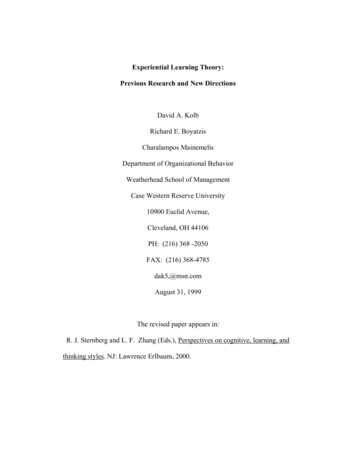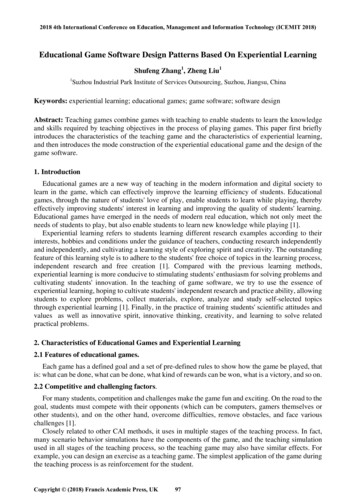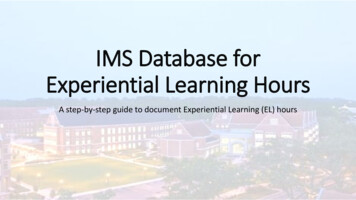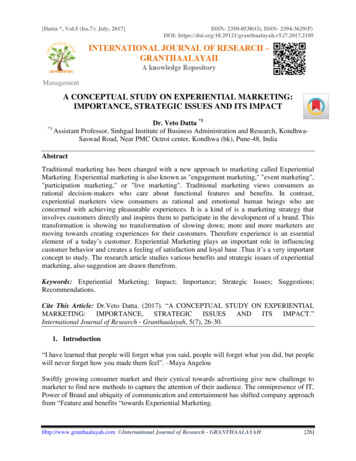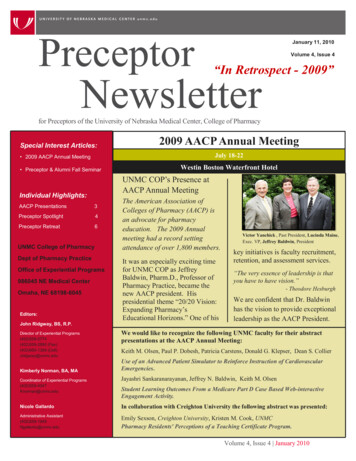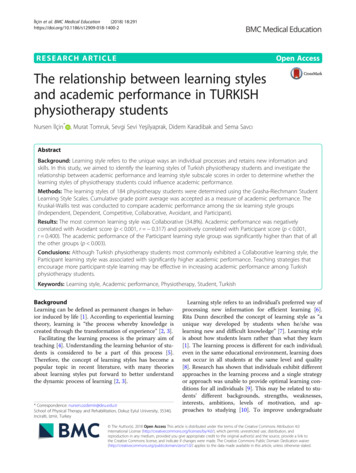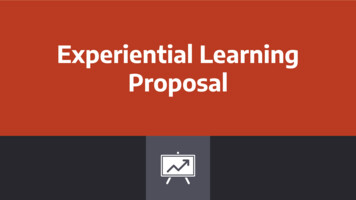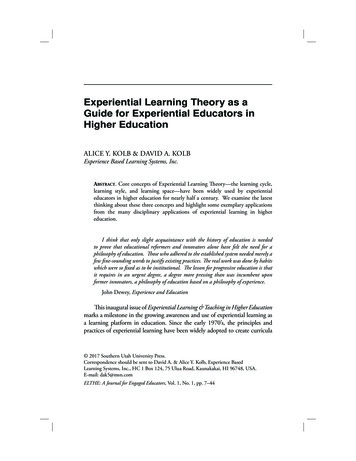
Transcription
Experiential Learning Theory as aGuide for Experiential Educators inHigher EducationALICE Y. KOLB & DAVID A. KOLBExperience Based Learning Systems, Inc.AbstrAct. Core concepts of Experiential Learning Theory—the learning cycle,learning style, and learning space—have been widely used by experientialeducators in higher education for nearly half a century. We examine the latestthinking about these three concepts and highlight some exemplary applicationsfrom the many disciplinary applications of experiential learning in highereducation.I think that only slight acquaintance with the history of education is neededto prove that educational reformers and innovators alone have felt the need for aphilosophy of education. Those who adhered to the established system needed merely afew fine-sounding words to justify existing practices. The real work was done by habitswhich were so fixed as to be institutional. The lesson for progressive education is thatit requires in an urgent degree, a degree more pressing than was incumbent uponformer innovators, a philosophy of education based on a philosophy of experience.John Dewey, Experience and EducationThis inaugural issue of Experiential Learning & Teaching in Higher Educationmarks a milestone in the growing awareness and use of experiential learning asa learning platform in education. Since the early 1970’s, the principles andpractices of experiential learning have been widely adopted to create curriculaElectronically published Month 01, 2016 2017 Southern Utah University Press.Correspondence should be sent to David A. & Alice Y. Kolb, Experience BasedLearning Systems, Inc., HC 1 Box 124, 75 Ulua Road, Kaunakakai, HI 96748, USA.E-mail: dak5@msn.comELTHE: A Journal for Engaged Educators, Vol. 1, No. 1, pp. 7–4400
Kolb & Kolband conduct educational courses and programs. Many of the non-traditionaleducational innovations that have flowered during this period, such ascompetency-based undergraduate education (Mentkowski 2000), professionaleducation (Boyatzis, Cowan & Kolb 1995), college programs for adult learners,and prior learning assessment (Keeton & Tate 1978; Simosko 1988) have usedexperiential learning as their educational platform. As experiential, learnercentered education has gained widespread acceptance in the twenty-first century(Prince & Felder 2006; Slavich & Zimbardo 2012), more and more educatorsare experimenting with experiential learning practices such as service learning(Bielefeldt et al. 2011; Brower 2011), problem based learning (Gurpinar, Bati& Tetik 2011; Bethell & Morgan 2011), action learning (Revans 1980; Keys1994; Foy 1977), adventure education (Fuller 2012; Timken & McNamee2012), and simulation and gaming (Taylor, Backlund & Niklasson 2012;Shields, Zawadzki & Johnson 2011; Schaefer et al. 2011).In their formulation of transformational teaching, George M. Slavichand Philip G. Zimbardo (2012) describe the multidimensional importanceof experience in learning:[E]xperiential lessons provide students with an opportunity to experienceconcepts first-hand and, as such, give students a richer, more meaningfulunderstanding of course concepts and of how they operate in the real world. . . .They enhance the affective quality of the course content. This occurs both whenstudents are engaged in solving problems that are part of the activities and whenthey are analyzing, sharing, discussing, and reflecting on their personal reactions. . . It can significantly improve students’ memory for concepts insofar as theinformation gets stored in autobiographical memory. . . . Experiential lessonshave the ability to shape students’ beliefs about learning and about the self. . . .They can lead to significant personal insights, including a greater awareness ofone’s personally held perspectives—as well as an improved awareness of otherpeople’s experience—with the possibility to enhance these attributes throughcritical reflection. (594)In his study of student careers after college, Jeffrey J. Selingo (2016)argues that co-curricular experiential learning experiences are what distinguishsuccessful careers from drifters:But it’s not just the college degree that separates the successful from the driftersthese days. If that were the case, recent college graduates wouldn’t be standing8ELTHE: A Journal for Engaged Educators
Experiential Learning Theory in Higher Educationin the unemployment line or settling for jobs that don’t require a bachelor’sdegree. While some sort of degree after high school remains the foundation of asuccessful life and career, other coming-of-age, real-world experiences in the lateteens and early twenties—particularly apprenticeships, jobs, or internships—actually matter more nowadays in moving from college to a career. (8-9)Selingo found that 79% of the most successful college graduates had at leastone college internship as well as other out of the classroom projects. Many educational institutions offer these co-curricular experiential education programs toadd a direct experience component to their traditional academic studies.In this essay we will examine these applications of experiential learningin higher education through the lens of Experiential Learning Theory(ELT) (D. Kolb 2015) by examining exemplary applications of experientiallearning concepts in several of the many disciplines of higher education.From the countless numbers of college teachers around the world who havebegun to define themselves as experiential educators, we have selected a fewdocumented examples of how ELT concepts are used in their work. Webegin with the central ELT concept of the learning cycle and how it canbe used to teach around the learning cycle. Two applications of the conceptin management education are described. Next, the ELT concept of learningstyle is addressed, emphasizing how its status as a dynamic state as opposedto a fixed trait is unique among the many learning style approaches. Traitlearning style approaches emphasize matching style to instructional methodwhile ELT learning styles emphasize learning flexibility and expanding one’spreferred style to encompass all learning modes for full cycle learning. Theapplication of this learning style concept to develop law students’ metalearning capabilities is described, and current research on adaptive learningsystems in digital education is examined. Finally, we turn to the concept oflearning space and examine two applications. One examines how a positivelearning identity can be developed in a hospitable learning space. Thisstudy addressed remedial mathematics education in a community college.The second example shows the power of conversational learning spaces in afreshman seminar general education college program.Vol. 1, No. 1 (2017)9
Kolb & KolbExperiential Learning TheoryELT was created to provide an intellectual foundation for the practice ofexperiential learning responding to John Dewey’s call for a theory of experienceto guide educational innovation. ELT is a synthesis of the works of those greatscholars who gave experience a central role in their theories of human learningand development. We have come to call them the “foundational scholars ofexperiential learning”: William James, John Dewey, Kurt Lewin, Jean Piaget,Lev Vygotsky, Carl Jung, Mary Parker Follett, Carl Rogers, and Paulo Freire.Figure 1 depicts these foundational scholars of ELT and a summary of theircontributions to experiential learning. Their contributions span over 100years, beginning at the end of the nineteenth century with William James,John Dewey, and Mary Parker Follett and ending at the end of the twentiethcentury with the deaths of Carl Rogers and Paulo Freire.Figure 1. Foundational Scholars of ELT10ELTHE: A Journal for Engaged Educators
Experiential Learning Theory in Higher EducationELT is a dynamic, holistic theory of the process of learning from experienceand a multi-dimensional model of adult development. The dynamic view oflearning is based on a learning cycle driven by the resolution of the dualdialectics of action/reflection and experience/ abstraction (see Figure 2). It is aholistic theory that defines learning as the major process of human adaptationinvolving the whole person. As such, ELT is applicable not only in the formaleducation classroom but in all arenas of life. The process of learning fromexperience is ubiquitous, present in human activity everywhere all the time.The holistic nature of the learning process means that it operates at all levelsof human society from the individual, to the group, to organizations, and tosociety as a whole.Figure 2. The Experiential Learning CycleVol. 1, No. 1 (2017)11
Kolb & KolbTo appreciate the holistic and dynamic nature of the learning cycle it isuseful to examine its philosophical foundations in the radical empiricism ofWilliam James. James (1904) proposed radical empiricism as a new philosophyof reality and mind which resolved the conflicts between nineteenth-centuryrationalism and empiricism as expressed in the philosophies of idealism andmaterialism. For James, everything begins and ends in the continuous fluxand flow of experience. In short, experience is all there is: “We start with thesupposition that there is only one primal stuff or material in the world, a stuffof which everything is composed. . . . we call that stuff ‘pure experience’”(1142). He goes on to write,In this formulation the duality between the mind (thought) and physical world(thing) is resolved since both are experienced but with different characteristics,thought is the concrete here-and-now experience “redoubled” in reflection. . . .If it be the self-same piece of pure experience taken twice over that serves nowas thought and now as thing . . . how comes it that its attributes should differso fundamentally in the two takings? As thing, the experience is extended; asthought, it occupies no space or place. As thing, it is red, hard, and heavy; butwho ever heard of a red, hard or heavy thought? (1153)Dewey stressed the dynamic nature of pure experiencing in the learningcycle, noting that ordinary experience is conservative, tradition-bound,and prone to conformity and dogmatism, being culturally mediated bymany previous trips around the learning cycle and saturated with previousconclusions. He emphasized that this conservative experience must beinterrupted to initiate reflection and learning. He argued that it was necessaryto reflect on experience in order to draw out the meaning in it and to use thatmeaning as a guide in future experiences; but he observed that the reflectiveprocess seemed to be initiated only by pure experiences that break out ofconservative experiencing, such as when we are “stuck” with a problem ordifficulty or “struck” by the strangeness of something outside of our usualexperience (Dewey 1933).The implication of the philosophy of radical empiricism for ELT and theexperiential learning cycle is that it is not only the Concrete Experience modeof pure experiencing that is experiential; all modes of the learning cycle areexperiences. Both modes of grasping experience—Concrete Experience (CE)and Abstract Conceptualization (AC)—and both modes of transformingexperience—Reflective Observation (RO) and Active Experimentation12ELTHE: A Journal for Engaged Educators
Experiential Learning Theory in Higher Education(AE)—are part of the experiential learning process. Many use the termexperiential learning to refer to exercises and games used to involve studentsin the learning process. However, a classroom lecture may be an abstractexperience but it is also a concrete one, when, for example, a learner admiresand imitates the lecturer. Likewise, a learner may work hard to create anabstract model in order to make sense of an internship experience orexperiential exercise. From the learner’s perspective, solitary reflection can bean intensely emotional concrete experience and the action of programming acomputer can be a highly abstract experience.Since ELT is a holistic theory of learning that identifies learning styledifferences among different academic specialties, it is not surprising to see thatELT research is highly interdisciplinary, addressing learning and educationalissues in many fields. ELT is being used extensively by experiential educatorsas a guide for practice in at least 30 fields and academic disciplines (Kolb &Kolb 2013). Included are research studies from every region of the world,with many contributions coming from the U. S., Canada, Brazil, the U. K.,China, India, Australia, Japan, Norway, Finland, Sweden, the Netherlands,and Thailand. Since its first statement in 1971 (Kolb, Rubin & McIntyre1971), there have been many studies using Experiential Learning Theoryto advance the theory and practice of experiential learning. Since 2000,ELT research in many fields around the world has more than quadrupled.The current experiential learning theory bibliographies include over 4,100entries dating between 1971 and 2016 (Kolb & Kolb 2016). A 2013 reviewof management education research (Arbaugh, DeArmond & Rau) showedthat 27% of the top-cited articles in management education journals wereabout experiential learning and learning styles. “Learning Styles and LearningSpaces” (Kolb & Kolb 2005) ranked second in a more extensive study ofthe 100 most-cited papers in management education research (Arbaugh &Hwang 2015), with papers about experiential learning and learning stylesaccounting for 9% of the total citations.Defining Experiential LearningFrom the perspective of ELT there is a widespread idea of whatexperiential learning is that fails to capture the full potential of the processof learning from experience. A common usage of the term defines it as aparticular form of learning from life experience, often contrasted with lectureVol. 1, No. 1 (2017)13
Kolb & Kolband classroom learning. Morris T. Keeton and Pamela J. Tate (1978) offeredthis definition of experiential learning: “[L]earning in which the learner isdirectly in touch with the realities being studied. It is contrasted with thelearner who only reads about, hears about, talks about, or writes about theserealities but never comes into contact with them as part of the learningprocess”(2). Thus, many people think about experiential activities such asexercises, role plays, ropes courses, games, and field projects when they hearthe term experiential learning. A similar limited definition of experientiallearning is found in theoretical scholarship. In The Ambiguities of Experience,the great organizational theorist James March (2010) contrasts his definitionof experiential knowledge, “lessons extracted from the ordinary course of lifeand work,” with academic knowledge “generated by systematic observationand analysis by experts and transmitted by authorities” (9). In this view ofexperiential learning, the emphasis is often on direct sense experience andin-context action as the primary source of learning, often down-playing arole for thinking, analysis, and academic knowledge. The definition ofexperiential learning as in-context experiencing and action is not the meaningof experiential learning as defined in ELT. Such a definition includes only halfof the learning cycle, ignoring the holistic, dialectic nature of the process oflearning from experience. The learning cycle is driven by the integration ofaction and reflection and experience and concept.The failure to view experiential learning as encompassing all four modesof the learning cycle and as applicable in all learning situations both in theclassroom and in life is, we believe, the source of many of the practical difficultiesencountered by experiential learning advocates in higher education. Mostnotably, there is a chasm between academic courses and experiential activitiesthat reduces the effectiveness of both. A service-learning program, for example,can bring students in contact with the realities of social conditions that asociology course seeks to explicate. Too often, however, the two activities areso separated that the benefits of classroom reflection and conceptual analysisare not integrated with the learners’ actions to bring change and improvementto the conditions they encounter in the service-learning project. The gulf isfurther expanded by the culture of higher education, which enshrines coursesin the credit-hour time-block system, giving them and the professors whoteach them high status while experiential programs are seen as ancillary andstaffed by lower status student development professionals.14ELTHE: A Journal for Engaged Educators
Experiential Learning Theory in Higher EducationTeaching around the Learning CycleThe cycle of learning from experience is perhaps the best known andwidely used concept of ELT. A Google image search of “learning cycle”produces a seemingly endless array of reproductions and variations of thecycle from around the world. The learning cycle was first applied in thelate 1960’s as part of a curriculum development project to use experientiallearning methods in a required organizational psychology course for MBA’sat the Sloan School of Management at MIT. The original course, a lectureformat with 150 students, was a way to structure learning experiences thatwould bring the fifteen topics covered in the lecture syllabus into the room.Concrete experiences generated by exercises, business games, role plays, andcases provided a common experiential starting point for participants andfaculty to explore the relevance of behavioral concepts for their work. Topicslike motivation, perception, and group decision-making were organizedaround the learning cycle providing the experience, structured reflectionand conversation exercises, conceptual material, and a personal applicationassignment. The teacher’s role was to manage a learning process that wasbasically learner-directed. They helped students to experience in a personaland immediate way the phenomena in their field of specialization. Theystood ready with alternative theories and concepts as students attempted toassimilate their observations into their own conception of the topic. Theyhelped students to deduce the implications of their conclusions for their ownlife and work and to test these implications through practical, real-worldexperience. The new approach proved quite successful and resulted in thefirst management textbook based on experiential learning (Kolb, Rubin &McIntyre 1971), which is now in its eighth edition (Osland et al. 2007).The most important aspect of the learning cycle is that it describes thelearning process as a recursive circle or spiral as opposed to the linear, traditionalinformation transmission model of learning used in most education, whereinformation is transferred from the teacher to the learner to be stored indeclarative memory for later recall. In the linear model, the learner is a passiverecipient of information. Learners, having no direct contact with the subject,are unable to investigate, explore, and judge for themselves. They are left onedown in a power relationship with only the choice of “taking the teacher’sword for it.” Teachers, for their part, are left in a one-way interaction thatis ultimately deadening and boring. Learners’ engagement is rewarded andVol. 1, No. 1 (2017)15
Kolb & Kolbmeasured only by points for participation and not by their ability to inquirein depth.For educators, the magic of experiential learning lies in the uniquerelationship that is created between the teacher, the learner, and the subjectmatter under study (see Figure 3). The experiential approach places the subjectto be learned in the center to be experienced by both the educator and learner.Using the cycle of learning, all participants receive information throughconcrete experience of the subject matter and transform it through reflectionand conceptualization and then transform it again by acting to change theworld including what information is attended to in the new experience. Theyare both receivers of information and creators of information. This has aleveling effect on relationships, to the extent that all can directly experiencethe subject. Everyone has a perspective on the subject. Those with differentlearning styles, for example, will view the subject experience through their ownway of processing experience. Questioning differences that arise from thesemultiple perspectives is the fuel for learning and new insights. Challengingthe expert’s viewpoint even becomes possible. This can be quite unsettling tonovice experiential educators, but it also becomes a source of unpredictablenew insight and learning for them. In becoming an experiential educatorwith this approach, the teacher also becomes an experiential learner. ParkerPalmer (1998), a strong advocate for the subject-centered approach, put itthis way:The subject-centered classroom is characterized by the fact that the third thing(the subject) has a presence so real, so vivid, so vocal, that it can hold teacher andstudents alike accountable for what they say and do. In such a classroom thereare no inert facts. The great thing is so alive that teacher can turn to studentor student to teacher, and either can make a claim on the other in the name ofthat great thing. Here teacher and students have a power beyond themselves tocontend with—the power of a subject that transcends our self-absorption andrefuses to be reduced to our claims about it. (117)16ELTHE: A Journal for Engaged Educators
Experiential Learning Theory in Higher EducationFigure 3. Subject Matter, Educator and Learner Relationships in the Discourseand Experiential Learning ModelsRecently, we have created a framework to assist educators in theirapplication of the ELT concepts of the learning cycle and learning style in thedynamic matching model of teaching around the learning cycle (A. Kolb et al.2014). In our interviews and observations of highly successful educators, wefind that they tend to organize their educational activities in such a mannerthat they address all four learning cycle modes—experiencing, reflecting,thinking, and acting—using some form of the dynamic matching model inthe roles they adopt. We developed a self-assessment instrument called theKolb Educator Role Profile (KERP) to help educators understand their ownteaching approach from the perspective of teaching around the learning cycle.The KERP describes four common educator roles: Facilitator, SubjectExpert, Standard-Setter/Evaluator, and Coach. To help learners move aroundthe learning cycle, educators must adapt their role, moving from Facilitatorto Subject Matter Expert to Standard-Setter/Evaluator to Coach, as shown inFigure 4.Vol. 1, No. 1 (2017)17
Kolb & KolbFigure 4. Educator Roles and Teaching around the Learning Cycle. The Facilitator Role. When facilitating, educators help learners get intouch with their personal experience and reflect on it. They adopt a warmaffirming style to draw out learners’ interests, intrinsic motivation, andself-knowledge. They often do this by facilitating conversation in smallgroups. They create personal relationships with learners. The Subject Expert Role. In their role as subject expert, educators helplearners organize and connect their reflections to the knowledge base ofthe subject matter. They adopt an authoritative, reflective style. They often teach by example, modeling and encouraging critical thinking as theysystematically organize and analyze the subject matter knowledge. Thisknowledge is often communicated through lectures and texts. The Standard-Setter/Evaluator Role. As a standard setter and evaluator,educators help learners master the application of knowledge and skillin order to meet performance requirements. They adopt an objectiveresults-oriented style as they set the knowledge requirements needed forquality performance. They create performance activities for learners toevaluate their learning.18ELTHE: A Journal for Engaged Educators
Experiential Learning Theory in Higher Education The Coaching Role. In the coaching role, educators help learners applyknowledge to achieve their goals. They adopt a collaborative, encouraging style, often working one-on-one with individuals to help themlearn from experiences in their life context. They assist in the creationof personal development plans and provide ways of getting feedback onperformance.Most of us adopt each of these roles to some extent in our educationaland teaching activities. This is in part because these roles are determined bythe way we resolve fundamental dilemmas of education. Do we focus onthe learner’s experience and interest or on subject matter requirements? Dowe focus on effective performance and action or on a deep understandingof the meaning of ideas? All are required for maximally effective learning.Individuals, however, tend to have a definite preference for one or tworoles over the others because of their educational philosophy, their personalteaching style, and the requirements of their particular educational setting,including administrative mandates and learner needs. The KERP assessmentinstrument is designed to help educators sharpen their awareness of thesepreferences and to make deliberate choices about what works best in aspecific situation. (The KERP is a free assessment available at g Cycle Applications in Higher EducationDissatisfied with the application of experiential methods in the businessclassroom, Barbara Dyer and David W. Schumann (1993) developed anexperiential learning laboratory classroom applied to their senior-levelmarketing advertising/promotion class. They addressed the shortcomingsthey saw by emphasizing two principles. First, they created a teacher/learnerrelationship that partnered with learners to facilitate their engagement withthe learning cycle instead of the traditional information transfer approach asdescribed above: “Educators have spent their time ‘parroting’ the instructionalapproaches of other teachers rather than ‘partnering’ experience andknowledge as intended by experiential learning models and the traditionallaboratory method” (32). Second, they created a laboratory experiencein marketing classrooms that went beyond a single concrete applicationexperience to create a course structure that spiraled through nine iterationsVol. 1, No. 1 (2017)19
Kolb & Kolbaround the learning cycle. The text assignments and lectures were integratedwith experiences generated from two types of learning tasks, multiple groupprojects and multiple individual case studies. The traditional performanceevaluations (multiple choice and essay exams) were eliminated altogether togive central focus on the recursive cycle of lecture, discussion, feedback, andhands-on experiences. At the completion of the course, students reportedincreased levels of critical thinking abilities and the capacity to apply andconnect theoretical knowledge with real-life business application.Cynthia A. Lengnick-Hall and Martha M. Sanders (1997) designed alearning system for graduate- and undergraduate-level management coursesstructured around the learning cycle to give students with different learningstyles a variety of ways to master each segment of the course material.Results indicate that despite wide variety in their learning styles, experiences,academic levels, and interests, students demonstrated consistently high levelsof personal effectiveness, organizational effectiveness, ability to apply coursematerials, and satisfaction with both course results and the learning process.The study also showed learning style differences in student ratings of variousoutcome measures; divergent learners rated their personal effectiveness higherthan the non-divergent learners, while assimilating learners rated the loweston the same outcome measure. Converging learners, on the other hand, ratedtheir ability to apply course material significantly higher than did the nonconverging learners, an indication of their tendency to seek out opportunitiesto apply what they have learned. Looking at the positive learning outcomesgenerated by the courses, the authors contend that high-quality learningsystems are the ones in which extensive individual differences are matchedwith a variety of options in learning methods, thus creating opportunitiesfor student behavioral, emotional, and intellectual transformation of lastingimpact.The Engineering and Technology College at Brigham Young Universityundertook a systematic change effort to introduce the ELT teaching aroundthe learning cycle model to the faculty and conducted training sessions forthe faculty in the use of the model (Harb et al. 1995). They developed samplecurricula for teaching around the cycle that addressed questions posed byeach quadrant of the learning cycle—Why, What, How, and What If. Theyfollowed a systematic change process for teacher development that involved80% of the faculty for an introductory session and 35 faculty volunteersfor the program. The program involved course development training and20ELTHE: A Journal for Engaged Educators
Experiential Learning Theory in Higher Educationimplementation of fall semester course designs that were evaluated byvideotaping and review sessions by the faculty support groups. One facultymember evaluated the program as follows:My effort as a faculty member to pass through the four types of learning activitieshas definitely increased. . . . The four-step process is definitely a practical andsimple reference frame to use as a skeleton for any concept, technique or principlethat needs to be taught. I believe that even though all of us as faculty and studentsmay tend to have a dominant learning style, my experience has shown me thatproviding learning experiences in all four of the quadrants enhances learning forjust about every person no matter what his dominant or preferred learning stylequadrant may be. As a result, my effort in designing learn
John Dewey, Experience and Education . While some sort of degree after high school remains the foundation of a successful life and career, other coming-of-age, real-world experiences in the late . of human society from the individual, to the group, to organizations, and to society as a whole. F
